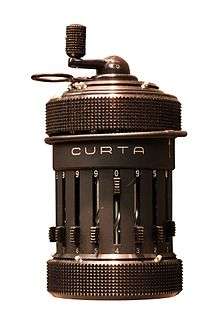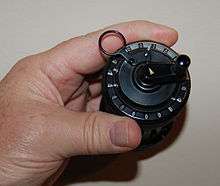Curta



The Curta is a small mechanical calculator developed by Curt Herzstark. The Curta's design is a descendant of Gottfried Leibniz's Stepped Reckoner and Charles Thomas's Arithmometer, accumulating values on cogs, which are added or complemented by a stepped drum mechanism. It has an extremely compact design: a small cylinder that fits in the palm of the hand.
Curtas were considered the best portable calculators available until they were displaced by electronic calculators in the 1970s.[1]
History
The Curta was conceived by Curt Herzstark in the 1930s in Vienna, Austria. By 1938, he had filed a key patent, covering his complemented stepped drum, Deutsches Reichspatent (German National Patent) No. 747073. This single drum replaced the multiple drums, typically around 10 or so, of contemporary calculators, and it enabled not only addition, but subtraction through nines complement math, essentially subtracting by adding. The nines' complement math breakthrough eliminated the significant mechanical complexity created when "borrowing" during subtraction. This drum would prove to be the key to the small, hand-held mechanical calculator the Curta would become.
His work on the pocket calculator stopped in 1938 when the Nazis forced him and his company to concentrate on manufacturing precision instruments for the German army.[2]
Herzstark, the son of a Catholic mother and Jewish father, was taken into custody in 1943 and eventually sent to Buchenwald concentration camp, where he was encouraged to continue his earlier research:
While I was imprisoned inside Buchenwald I had, after a few days, told the [people] in the work production scheduling department of my ideas. The head of the department, Mr. Munich said, 'See, Herzstark, I understand you've been working on a new thing, a small calculating machine. Do you know, I can give you a tip. We will allow you to make and draw everything. If it is really worth something, then we will give it to the Führer as a present after we win the war. Then, surely, you will be made an Aryan.' For me, that was the first time I thought to myself, my God, if you do this, you can extend your life. And then and there I started to draw the CURTA, the way I had imagined it.[3][2]
In the camp, Herzstark was able to develop working drawings for a manufacturable device. Buchenwald was liberated by U.S. troops on April 11, 1945, and by November Herzstark had located a factory in Sommertal, near Weimar, whose machinists were skilled enough to produce three working prototypes.[3]
Soviet forces had arrived in July, and Herzstark feared being sent to Russia, so, later that same month, he fled to Austria. He began to look for financial backers, at the same time filing continuing patents as well as several additional patents to protect his work. The Prince of Liechtenstein eventually showed interest in the manufacture of the device, and soon a newly formed company, Contina AG Mauren, began production in Liechtenstein.
It was not long before Herzstark's financial backers, thinking they had got from him all they needed, contrived to force him out by reducing to zero the value of all of the company's existing stock, including his one-third interest.[1] These were the same people who had earlier elected not to have Herzstark transfer ownership of his patents to the company, so that, should anyone sue, they would be suing Herzstark, not the company, thereby protecting themselves at Herzstark's expense. This ploy now backfired: without the patent rights, they could manufacture nothing. Herzstark was able to negotiate a new agreement, and money continued to flow to him.
Curtas were considered the best portable calculators available until they were displaced by electronic calculators in the 1970s.[1] Herzstark continued to make money from his invention until that time, although, like many inventors before him, he was not among those who profited the most from his invention. The Curta, however, lives on, being a highly popular collectible, with thousands of machines working just as smoothly as they did at the time of their manufacture 40, 50 or 60 years previous.[1][3][4]
Cost
The Curta Type I was sold for $125 in the later years of production, and the Type II was sold for $175. While only 3% of Curtas were returned to the factory for warranty repair,[3] a small, but significant number of buyers returned their Curtas in pieces, having attempted to disassemble them. Reassembling the machine was more difficult, requiring intimate knowledge of the orientation of, and installation order for, each part and sub-assembly, plus special guides designed to hold the pieces in place during assembly. Also, many identical looking parts, each with slightly different dimensions, required test fitting and selection as well as special tools to adjust tolerances.[5]
The machines currently have a high curiosity value and sell for around US$1,000, but going as high as US$1,900 for models in a pristine condition with notable numbers.[2]
Design
Numbers are entered using slides (one slide per digit) on the side of the device. The revolution counter and result counter reside around the shiftable carriage, at the top of the machine. A single turn of the crank adds the input number to the result counter, at any carriage position, and increments the corresponding digit of the revolution counter. Pulling the crank upwards slightly before turning performs a subtraction instead of an addition. Multiplication, division, and other functions require a series of crank and carriage-shifting operations.
The Curta was affectionately known as the "pepper grinder" or "peppermill" due to its shape and means of operation. It was also termed the "math grenade" due to its superficial resemblance to a certain type of hand grenade.[6]
Models
The Type I Curta has eight digits for data entry (known as "setting sliders"), a six-digit revolution counter, and an eleven-digit result counter. According to the advertising literature, it weighs only 8 ounces (230 g). Serial number 70154, produced in 1969, weighs 245 grams (8.6 oz).
The larger Type II Curta, introduced in 1954, has eleven digits for data entry, an eight-digit revolution counter, and a fifteen-digit result counter. It weighs 13.15 ounces (373 g), based on weighing serial number 550973, produced in early 1966.
An estimated 140,000 Curta calculators were made (80,000 Type I and 60,000 Type II). According to Curt Herzstark, the last Curta was produced in 1972.[3]
Uses
The Curta was popular among contestants in sports car rallies during the 1960s, 1970s and into the 1980s. Even after the introduction of the electronic calculator for other purposes, they were used in time-speed-distance (TSD) rallies to aid in computation of times to checkpoints, distances off-course and so on, since the early electronic calculators did not fare well with the bounces and jolts of rally racing.[1]
Contestants who used such calculators were often called "Curta-crankers" by those who were limited to paper and pencil, or who used computers linked to the car's wheels.[7]
The Curta was also favored by commercial and general-aviation pilots before the advent of electronic calculators because of its precision and the user's ability to confirm the accuracy of his or her manipulations via the revolution counter. Because calculations such as weight and balance are critical for safe flight, precise results free of pilot error are essential.
Popular culture
The Curta plays a role in William Gibson's Pattern Recognition (2003) as an interesting piece of historic computing machinery as well as a crucial "trade" item.
In 2016 a Curta was designed by Marcus Wu that could be produced on a 3D printer.[8] The fine tolerances needed are beyond present printer technology and this means the Curta has to be much bigger, about the size of a coffee can. Mythbuster Adam Savage received one fully printed and assembled at 3x scale from Wu.[9] Wu's creation weighs about three pounds.[10]
Further reading
Kein Geschenk für den Führer (No gift for the leader) by Curt Herzstark ISBN 3833411368
References
- 1 2 3 4 5 Stoll, Cliff (January 2004). "The Curious History of the First Pocket Calculator". Scientific American. 290 (1): 92–9. doi:10.1038/scientificamerican0104-92. PMID 14682043.
- 1 2 3 "Curta calculator: The mechanical marvel born in a Nazi death camp". newatlas.com. Retrieved 2016-10-18.
- 1 2 3 4 5 "An Interview with Curt Herzstark" conducted by Erwin Tomash, Charles Babbage Institute, University of Minnesota, Minneapolis. Herzstark interview in German
- ↑ Curt Herzstark and his Pocket Calculator, Peter Kradolfer, backup 6/88 pp. 5–9
- ↑ Several specialized Curta tools pictured at curta.li
- ↑ "ICES Insight" (PDF). Vol. 48. International Council for the Exploration of the Sea. September 2011. p. 13. ISBN 978-87-7482-097-0. Retrieved 2015-08-25.
- ↑ Webb, Simon (2008-02-27). "Pocket calculator fit for a Fuhrer". BBC. Retrieved December 3, 2016.
- ↑ The 3D-Printed Curta Calculator on Thingiverse
- ↑ The 3D-Printed Curta Calculator - YouTube
- ↑ This Retro Mechanical Calculator Has Gorgeous 3D-Printed Guts
External links
| Wikimedia Commons has media related to Curta calculator. |
- Curta I Vintage Calculators Web Museum: Mechanical Calculators
- Curta.org
- The CURTA Calculator Page
- Home of www.curtamania.com Many resources
- http://www.curta.ch Information about Curta / Video about the assembly of a Curta / Book about Curt Herzstark (Kein Geschenk für den Führer - Schicksal eines begnadeten Erfinders)
- curta.li: model history, user and service manuals, parts photos, blueprints, etc.
- YACS-Yet Another Curta Simulator. A 3D Simulator in VRML
- Type and Age of your Curta
- A 3D printed working model (reddit)
- Curta.fr Mainly focused on maintenance, repair and support. In french.